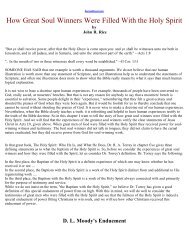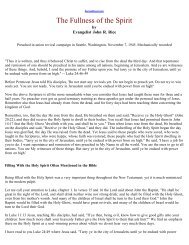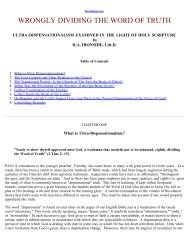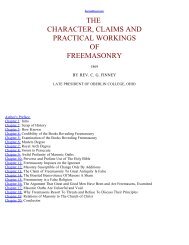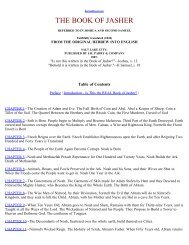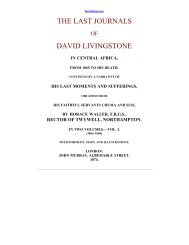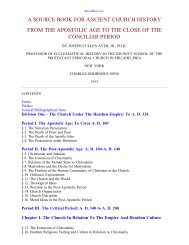Legends of Babylon and Egypt in Relation to Hebrew Tradition.pdf
Legends of Babylon and Egypt in Relation to Hebrew Tradition.pdf
Legends of Babylon and Egypt in Relation to Hebrew Tradition.pdf
You also want an ePaper? Increase the reach of your titles
YUMPU automatically turns print PDFs into web optimized ePapers that Google loves.
So much, then, for the <strong>in</strong>fluence <strong>of</strong> <strong>Babylon</strong>. We have seen that no similar problem arises with regard <strong>to</strong> the legends <strong>of</strong><br />
<strong>Egypt</strong>. At first sight this may seem strange, for <strong>Egypt</strong> lay nearer than <strong>Babylon</strong> <strong>to</strong> Palest<strong>in</strong>e, <strong>and</strong> political <strong>and</strong><br />
commercial <strong>in</strong>tercourse was at least as close. We have already noted how <strong>Egypt</strong> <strong>in</strong>fluenced Semitic art, <strong>and</strong> how she<br />
<strong>of</strong>fered an ideal, on the material side <strong>of</strong> her existence, which was readily adopted by her smaller neighbours.<br />
Moreover, the Joseph traditions <strong>in</strong> Genesis give a remarkably accurate picture <strong>of</strong> ancient <strong>Egypt</strong>ian life; <strong>and</strong> even the<br />
<strong>Egypt</strong>ian proper names embedded <strong>in</strong> that narrative may be paralleled with native <strong>Egypt</strong>ian names than that <strong>to</strong> which<br />
the traditions refer. Why then is it that the actual myths <strong>and</strong> legends <strong>of</strong> <strong>Egypt</strong> concern<strong>in</strong>g the orig<strong>in</strong> <strong>of</strong> the world <strong>and</strong><br />
its civilization should have failed <strong>to</strong> impress the <strong>Hebrew</strong> m<strong>in</strong>d, which, on the other h<strong>and</strong>, was so responsive <strong>to</strong> those <strong>of</strong><br />
<strong>Babylon</strong>?<br />
One obvious answer would be, that it was Nebuchadnezzar II, <strong>and</strong> not Necho, who carried the Jews captive. And we<br />
may readily admit that the Captivity must have tended <strong>to</strong> perpetuate <strong>and</strong> <strong>in</strong>tensify the effects <strong>of</strong> any <strong>Babylon</strong>ian<br />
<strong>in</strong>fluence that may have previously been felt. But I th<strong>in</strong>k there is a wider <strong>and</strong> <strong>in</strong> that sense a better answer than that.<br />
I do not propose <strong>to</strong> embark at this late hour on what ethnologists know as the "Hamitic" problem. But it is a fact that<br />
many strik<strong>in</strong>g parallels <strong>to</strong> <strong>Egypt</strong>ian religious belief <strong>and</strong> practice have been traced among races <strong>of</strong> the Sudan <strong>and</strong> East<br />
Africa. These are perhaps <strong>in</strong> part <strong>to</strong> be expla<strong>in</strong>ed as the result <strong>of</strong> contact <strong>and</strong> cultural <strong>in</strong>heritance. But at the same time<br />
they are evidence <strong>of</strong> an African, but non-Negroid, substratum <strong>in</strong> the religion <strong>of</strong> ancient <strong>Egypt</strong>. In spite <strong>of</strong> his pro<strong>to</strong>-<br />
Semitic stra<strong>in</strong>, the ancient <strong>Egypt</strong>ian himself never became a Semite. The Nile Valley, at any rate until the Moslem<br />
conquest, was stronger than its <strong>in</strong>vaders; it received <strong>and</strong> moulded them <strong>to</strong> its own ideal. This quality was shared <strong>in</strong><br />
some degree by the Euphrates Valley. But <strong>Babylon</strong>ia was not endowed with <strong>Egypt</strong>'s isolation; she was always open on<br />
the south <strong>and</strong> west <strong>to</strong> the Arabian nomad, who at a far earlier period sealed her Semitic type.<br />
To such racial division <strong>and</strong> aff<strong>in</strong>ity I th<strong>in</strong>k we may confidently trace the <strong>in</strong>fluence exerted by <strong>Egypt</strong> <strong>and</strong> <strong>Babylon</strong><br />
respectively upon <strong>Hebrew</strong> tradition.<br />
APPENDIX I<br />
COMPARATIVE TABLE OF THE SUMERIAN, SEMITIC-BABYLONIAN, HELLENISTIC, AND HEBREW<br />
VERSIONS OF CREATION, ANTEDILUVIAN HISTORY, AND THE DELUGE<br />
N.B.--Parallels with the new Sumerian Version are <strong>in</strong> upper-case.<br />
Sumerian Version. Seven Tablets Gilgamesh Epic, XI Berossus['Damscius] Earlier Heb. (J) Later Heb. (P) [No heaven<br />
or earth No heaven or earth Darkness <strong>and</strong> water Creation <strong>of</strong> earth Earth without form First Creation from Primaeval<br />
water- [Primaeval water- <strong>and</strong> heaven <strong>and</strong> void; darkness primaeval water gods: Apsû-Tiamat, gods: {'Apason- No<br />
plant or herb on face <strong>of</strong> /tehôm/, without conflict; Mummu Tauthe}, {Moumis} Ground watered by the primaeval<br />
water cf. Later Sum. Ver. Generation <strong>of</strong>: Generation <strong>of</strong>: mist (or flood) Div<strong>in</strong>e spirit mov<strong>in</strong>g Lakhmu-Lakhamu<br />
{Lakhos-Lakhe} [cf. Sumerian (hover<strong>in</strong>g, brood<strong>in</strong>g) Anshar-Kishar {'Assoros-Kissare} irrigation myth <strong>of</strong> upon face <strong>of</strong><br />
waters Creation]<br />
The great gods: Birth <strong>of</strong> great gods: Birth <strong>of</strong> great gods: ANU, ENLIL, ENKI, ANU, Nudimmud (=EA) {'Anos,<br />
'Ill<strong>in</strong>os, <strong>and</strong> N<strong>in</strong>kharsagga, Apsû <strong>and</strong> Tiamat 'Aos, 'Aois-Lauke, creat<strong>in</strong>g deities revolt Belos] Conquest <strong>of</strong> Tiamat<br />
Conquest <strong>of</strong> {'Omorka}, Creation <strong>of</strong> light by Marduk as Sun- or {Thamte}, by god {Belos} Creation <strong>of</strong> cover<strong>in</strong>g<br />
Creation <strong>of</strong> heaven <strong>and</strong> Creation <strong>of</strong> firmament, for heaven from earth from two halves or heaven, <strong>to</strong> divide half <strong>of</strong><br />
Tiamat's <strong>of</strong> body <strong>of</strong> Thamte waters; followed by body, <strong>to</strong> keep her emergence <strong>of</strong> l<strong>and</strong> waters <strong>in</strong> place Creation <strong>of</strong><br />
vegetation Creation <strong>of</strong> lum<strong>in</strong>aries Creation <strong>of</strong> lum<strong>in</strong>aries Creation <strong>of</strong> lum<strong>in</strong>aries [Creation <strong>of</strong> (probable order) Creation<br />
<strong>of</strong> animals vegetation]<br />
REASON FOR MAN'S REASON FOR MAN'S CREATION: worship <strong>of</strong> CREATION: worship <strong>of</strong> gods gods Creation



